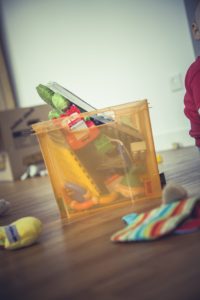Guide to handling a hoarding spouse
Don’t Get Buried: How To Deal With A Hoarding Spouse
Hoarding is a serious mental health issue that goes far beyond overconsumption or living in an unorganized home. Psychologists estimate that somewhere between 2 and 5 percent of the U.S. population displays some form of hoarding behavior, while other research claims more than 4 million Americans suffer from full-blown hoarding disorder. However, what happens when you aren’t the hoarder, but your partner is? How can you help a hoarding spouse without losing your mind?
Understanding the Disorder & Its Dangers
So, your garage is filled from floor to ceiling with storage bins that haven’t been opened in decades, or maybe you have to navigate stacks of books just to get from one side of the house to the other. In order to help your spouse let go, you’ll first need to understand the difference between being a “pack rat” and being a full-on hoarder.
Look around your house. We’re all guilty of having more possessions than we really need, and for many of us, it’s a daily struggle just to keep it all organized. Here are a few everyday signs that your spouse might have an extreme hoarding issue:
- There is a compulsive need to acquire.
- Your spouse has a concrete emotional bond to the items and is unable or unwilling to discard anything.
- The activities you can do in your home are impeded by the amount of space the items take up. This includes simple, everyday activities like cooking, bathing or eating together at the dining room table.
- Both the items and the act of hoarding interfere with your family’s life, especially when inviting guests over.
- Your spouse suffers from depression, anxiety or attention deficit disorder.
- Your partner feels shame or embarrassment and will often refuse to discuss the hoarding.
- Trouble getting and staying organized.
- Your spouse often acquires and saves items without knowing their purpose or use.
- Difficulty turning away from a “good deal,” even if there’s no current or future need for the item.
- There are boxes that haven’t been opened or organized in a substantial amount of time.

A small percentage of people with hoarding disorder will take and keep items that do not belong to them. Though this number is small, it’s a habit that is extremely dangerous. Other dangers that come from hoarding include:
- Hoarding can often result in an unsanitary environment, which can attract insects and rodents that carry disease.
- The excessive amount of stuff can be a real and serious fire hazard.
- The difficulty navigating through the house can cause harm and injury to others. There is even a possibility of getting trapped.
- If items sit for too long, they can become toxic and expose your family to hazardous materials.
Tips for Dealing with the Hoard and Helping Your Spouse Cope
This simply isn’t a matter of dealing with something that is annoying you, though there is, of course, merit in that feeling of frustration that your spouse doesn’t consider your needs. Hoarding disorder is a sign of a bigger emotional or mental problem, and can also pose a serious health risk to you and your family. Once you understand what hoarding is, you can start working on what to do about it.
First, you have to manage how to live in the hoard before you can help your partner work through their disorder.
- Go with your spouse to talk to a therapist or a psychologist about the situation. You may want to bring pictures of your home.
- Install fire alarms in every room where your partner stores belongings. Install a fire security system with water sprinklers if the hoarding is extreme.
- Never move or throw away any of your partner’s belongings.
- If you have any pets, you’ll need to keep them safe. Keep them out of the rooms that are packed the fullest. If your partner is hoarding animals, call an animal rescue service immediately.
- With your spouse’s agreement and assistance, see if there are items that can be moved into a climate-controlled storage facility for safekeeping.

Once you’ve helped make the environment safer and cleaner, and laid the foundation for working on mental and emotional issues, you can start to help your partner cope with their disorder. Like many mental health situations, this will take time and patience on your end. It would probably be very helpful for you to see a therapist as well, as you’ll have plenty of your own mixed-up emotions to conquer. When helping your spouse cope, try to remember to:
- Cheer them up and support them when they make small victories.
- Not enable the behavior by taking your partner shopping or running to the store to make purchases for him or her.
- Avoid taking or moving any of their possessions. This could put a huge wedge between the two of you, causing even further resentment and mistrust.
- Volunteer to help your partner sort through the items, and even help come up with a system for categorizing their possessions. Make sure that there is a “might keep” category to help them gently come to agree to let go of an item.
- Understand that getting rid of an item causes your partner great emotional and psychological distress.
- Strike a balance between keeping your home safe, but not cleaning up after him or her. Instead, clean up with your partner, and always make sure they are involved.
Tips for How to Cope Yourself
Even after all of this time and talk, you may still be wondering why your partner feels the need to acquire and store all of this “junk.” You may feel that you aren’t enough, or that there is some deep sadness in your spouse that you cannot touch. It’s just as important that you be as compassionate and patient with yourself as you are with a hoarder. You can help yourself cope with this stressful situation by:
- Creating a space that’s all your own. Maybe it’s an extra bedroom, an office or an outside area, but find a dedicated space where you can escape the clutter.
- Finding a hobby that gets you out of the house and allows you to release physical tension, like running, bike riding, walking or working out.
- Taking up meditation. A home filled with clutter can leak into the mind. The stress of storing material possessions can burden your inner space as well as your outer space. Take 10 minutes a day to go somewhere peaceful, focus on your breath and clear your mind. You can also take up a yoga or Tai Chi class.
- Remembering that your partner will likely improve over time, especially if you’ve brought in a specialist who deals with hoarding cases. When frustrated, try to focus on recent successes.
- Finding support. Go to a family support group to meet with and connect with other people dealing with a partner with a mental health issue. It’s important that you realize you are not alone.
A healthy view of your partner will result in a healthier view of your relationship. There will certainly be times when you are angry, frustrated and feel taken advantage of. These emotions will likely wind up leaving you feeling guilty and small. Dealing with a partner who hoards means you have to help them cope while you are also addressing your own self-care needs. That takes an amazing amount of fortitude and strength, but you have to know your limits. Set boundaries, be honest and look for opportunities to enjoy spending time together.



